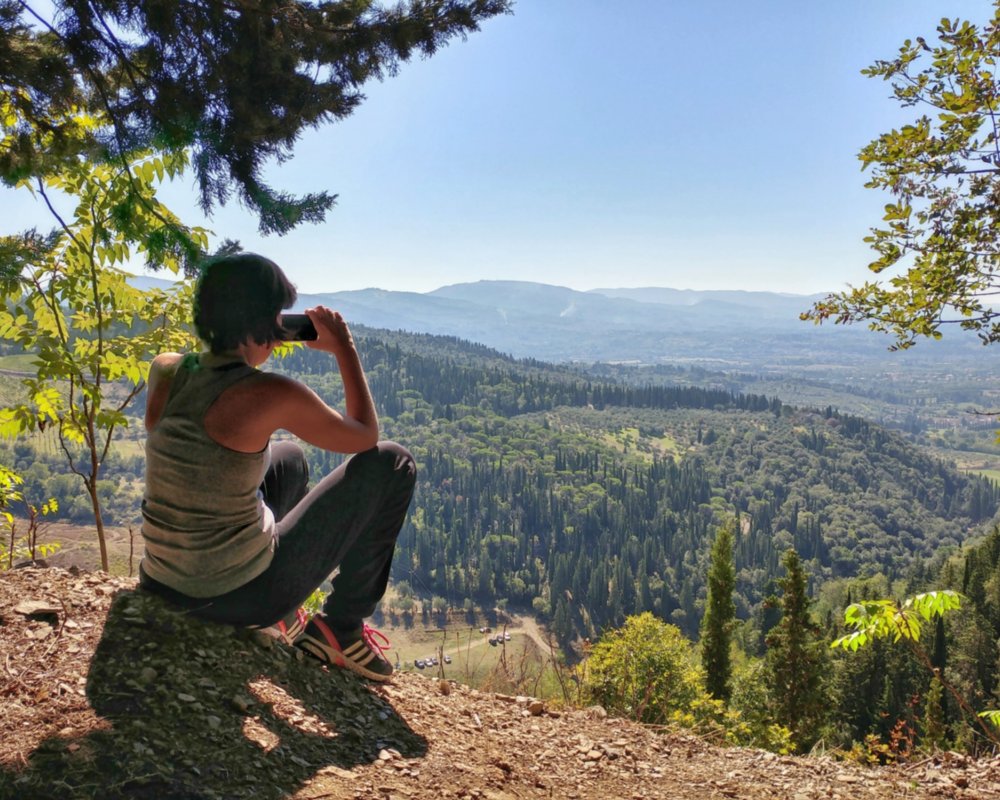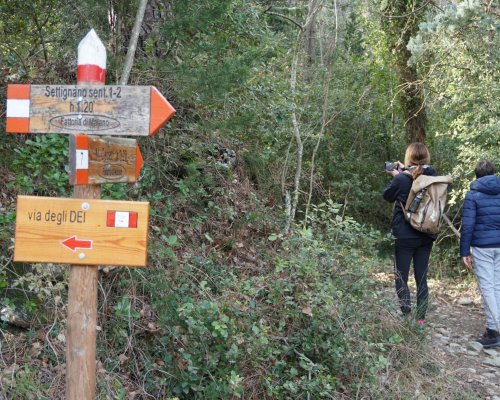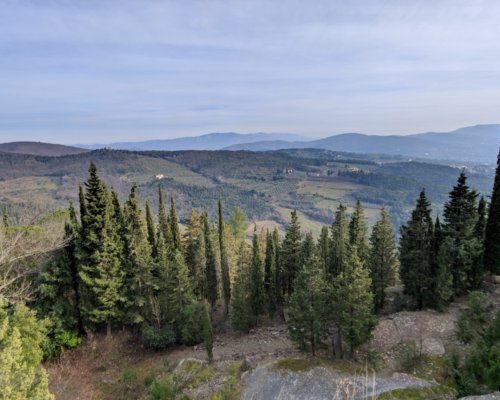Itinerary on Mount Ceceri between history and legend
Just a short distance from Fiesole, the Parco di Monte Ceceri (Mount Ceceri Park) preserves an ancient reserve of Pietra Serena stone used over the centuries for the construction of Fiesole’s and Florence's most prestigious monuments. Despite its modest altitude of about 400 meters, Mount Ceceri also seems to have been an important place of inspiration for Leonardo da Vinci, when around 1500 he designed his greatest flying machine: the "Great Kite." Indeed, it was on the slopes of Mount Ceceri that Leonardo observed the flight of the birds he was inspired by, and it was also here that he apparently tested his machine.
Today, the 44-hectare nature reserve can be explored along a network of paths, perfect for a walk in the green through historic quarries and scenic views. As a reminder of the bond with the great Genius, in the square named after Leonardo, inside the Park, there is a stone engraved with the famous phrase taken from the Codex on the Flight of Birds: "Piglierà il primo volo il grande uccello, sopra del dosso del suo magno cecero, empiendo l'universo di stupore, di sua fama tutte le scritture e gloria eterna il nido dove nacque."
This mountain takes its name from the fact that in the past it was populated by swans (in Italian cigni), defined by the Florentines "ceceri" due to the black bump on the beak, which, according to the hunters of the time, resembles a chick-pea.
The itinerary that we propose starts from the slopes of the mountain and leads to Piazzale Leonardo along the path 7 of the CAI, following a short stretch of the Via Degli Dei. The route starts from the Cave di Maiano, you can get by car and leave it in the parking lot or by public transport taking the Ataf buses. Near the bus stop, climbing enthusiasts can enjoy a large rock gym on the wall of the old quarry, marked by more than 40 climbing routes reaching up to 25 meters.
After a few tens of meters of asphalt road and then dirt road, the walk continues along an undergrowth path. The CAI road signs will take you to the highest peaks of Monte Ceceri passing by some historical quarries, such as the Cava Sarti, a former open air excavation area located right under the Piazzale Leonardo.
This mountain takes its name from the fact that in the past it was populated by swans (in Italian cigni), defined by the Florentines "ceceri" due to the black bump on the beak, which, according to the hunters of the time, resembles a chick-pea.
The itinerary that we propose starts from the slopes of the mountain and leads to Piazzale Leonardo along the path 7 of the CAI, following a short stretch of the Via Degli Dei. The route starts from the Cave di Maiano, you can get by car and leave it in the parking lot or by public transport taking the Ataf buses. Near the bus stop, climbing enthusiasts can enjoy a large rock gym on the wall of the old quarry, marked by more than 40 climbing routes reaching up to 25 meters.
After a few tens of meters of asphalt road and then dirt road, the walk continues along an undergrowth path. The CAI road signs will take you to the highest peaks of Monte Ceceri passing by some historical quarries, such as the Cava Sarti, a former open air excavation area located right under the Piazzale Leonardo.
After about 50 minutes of walk, you will reach Piazzale Leonardo, the ideal vantage point for a break. Both the Piazzale Leonardo and the large open space next to the Cava Sarti are equipped with benches and picnic tables.
This square probably was the place where in 1500 Leonardo tested his flying machine, an artifact with two large wings made of membranes, to be used with pedals and levers and a cockpit for the pilot. The machine had a wingspan of 30 arms (about 18 meters) and took the name of Grande Nibbio, "l’uccello di rapina ch’io vidi andando a Fiesole" (the bird of prey I saw while I was walking to Fiesole), to quote Leonardo himself.
Legend has it that the first flight aboard the machine was made by Tommaso Masini, a friend of Leonardo, also known as Zoroastro da Peretola: gliding a thousand meters from Mount Ceceri made an unlucky (but not fatal) landing in the nearby countryside.
After about 50 minutes of walk, you will reach Piazzale Leonardo, the ideal vantage point for a break. Both the Piazzale Leonardo and the large open space next to the Cava Sarti are equipped with benches and picnic tables.
This square probably was the place where in 1500 Leonardo tested his flying machine, an artifact with two large wings made of membranes, to be used with pedals and levers and a cockpit for the pilot. The machine had a wingspan of 30 arms (about 18 meters) and took the name of Grande Nibbio, "l’uccello di rapina ch’io vidi andando a Fiesole" (the bird of prey I saw while I was walking to Fiesole), to quote Leonardo himself.
Legend has it that the first flight aboard the machine was made by Tommaso Masini, a friend of Leonardo, also known as Zoroastro da Peretola: gliding a thousand meters from Mount Ceceri made an unlucky (but not fatal) landing in the nearby countryside.
The journey continues downhill towards Fiesole, first along path 1 of the CAI and then along Via degli Scalpellini, which will lead you off the tree-lined path until you rejoin Via di Monte Ceceri, a scenic road with breathtaking views over Florence. At this point, we suggest that you proceed with the utmost care, as you will find yourself traveling again through roads also passed by cars. After few hundred meters, take Via Verdi to reach Piazza Mino, the main square of Fiesole.
Here you can visit some of the emblematic monuments made using the precious stone (the Pietra Serena we already mentioned) from the ancient quarries: the Roman theater inside the Museo Civico Archeologico di Fiesole and the cattedrale di San Romolo, erected in 1028 and restored in the nineteenth century, which houses two paintings by Pietro Cristoforo Vannucci, known as Il Perugino.
The journey continues downhill towards Fiesole, first along path 1 of the CAI and then along Via degli Scalpellini, which will lead you off the tree-lined path until you rejoin Via di Monte Ceceri, a scenic road with breathtaking views over Florence. At this point, we suggest that you proceed with the utmost care, as you will find yourself traveling again through roads also passed by cars. After few hundred meters, take Via Verdi to reach Piazza Mino, the main square of Fiesole.
Here you can visit some of the emblematic monuments made using the precious stone (the Pietra Serena we already mentioned) from the ancient quarries: the Roman theater inside the Museo Civico Archeologico di Fiesole and the cattedrale di San Romolo, erected in 1028 and restored in the nineteenth century, which houses two paintings by Pietro Cristoforo Vannucci, known as Il Perugino.


